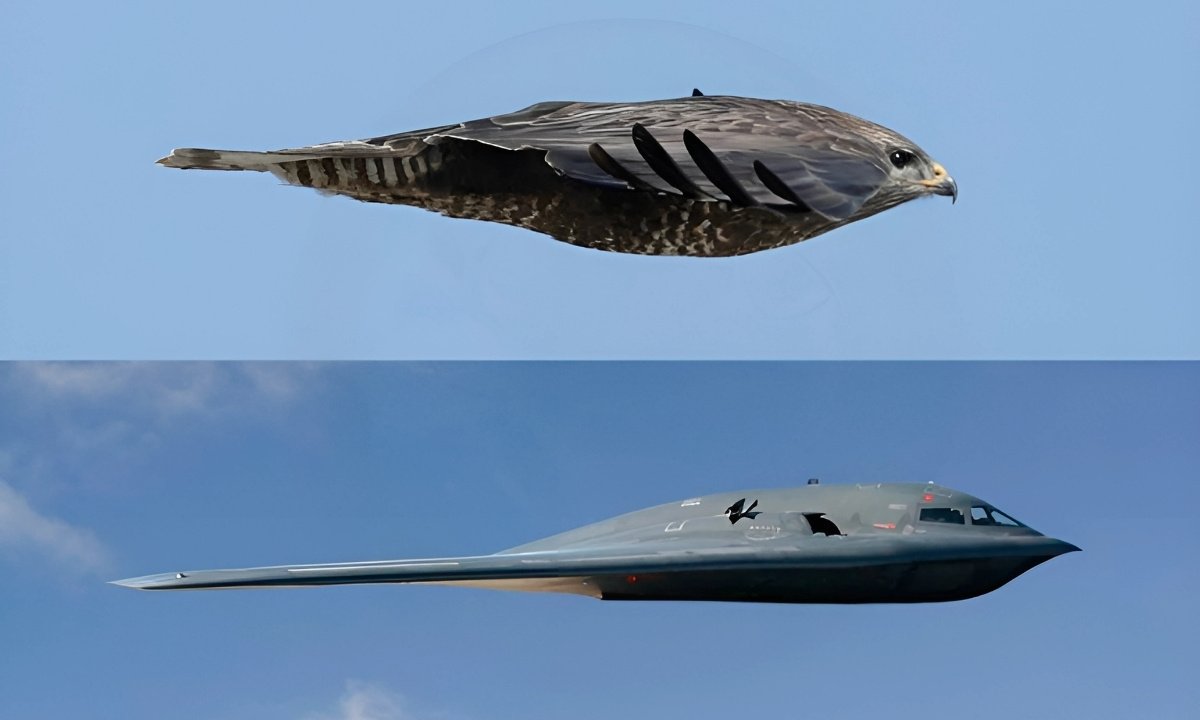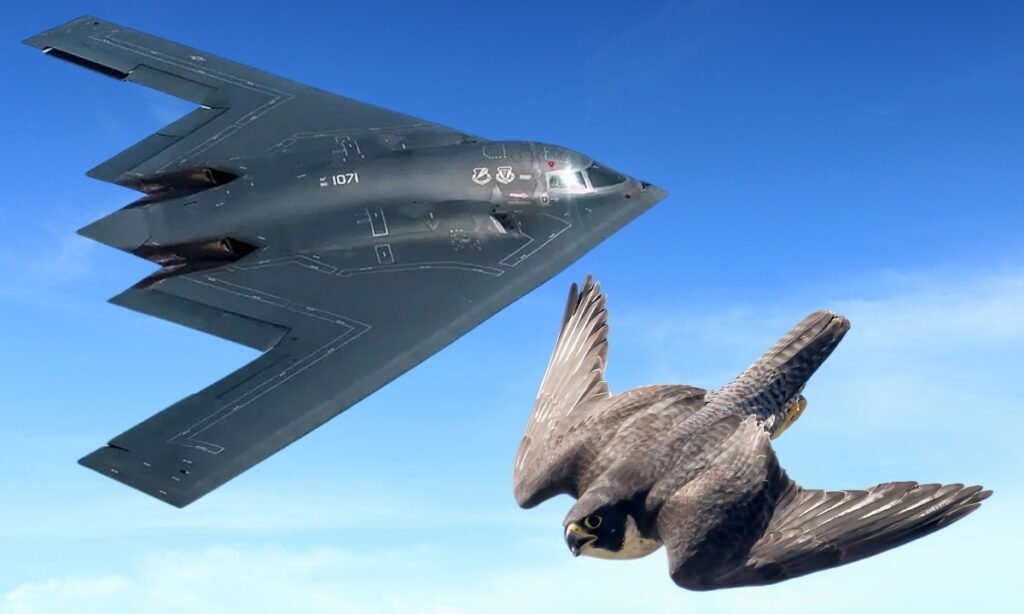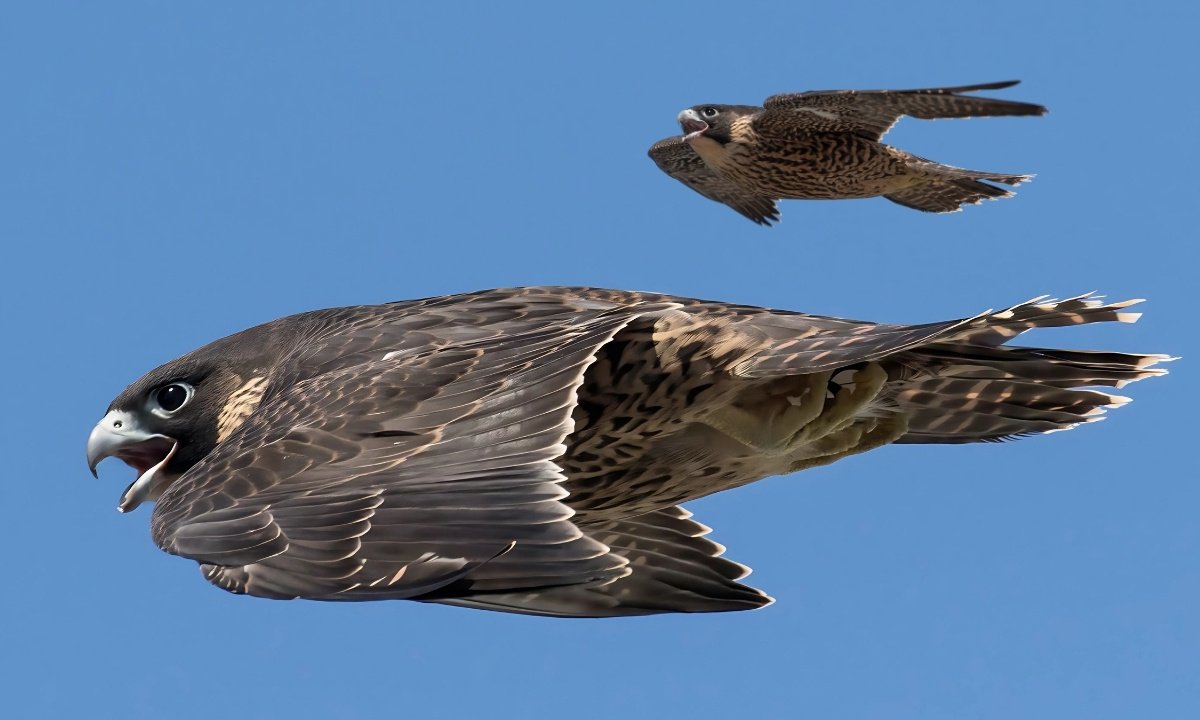Nature’s Blueprint: How the Peregrine Falcon Shaped the B-2 Stealth Bomber
You’ve probably noticed a falcon flying overhead, a demonstration of agility and velocity. But did you know that the bird of flight inspired one of the most advanced aircraft ever built? The Northrop B-2 Spirit, nicknamed the Stealth Bomber, has much of its innovative design due to birds, namely the peregrine falcon.
The bomber itself is not merely a pretty face; it’s an aerodynamics textbook and stealth borrowed from nature’s own designs. The B-2’s blended-wing fuselage that enables it to cut through the air with minimal resistance is a direct translation of what has been learned from studying how birds are designed to fly efficiently. This is a story of biomimicry, where engineers seek solutions in nature to fix difficult challenges.
Let’s observe how the world’s fastest bird influenced this symbol of flight.
1. The Peregrine Falcon: A Masterclass in Speed and Stealth
Let’s begin with the bird. The peregrine falcon is an engineering wonder, built for one task alone: to catch other birds mid-air.
- Definition: The peregrine falcon is a bird of prey renowned for its breathtaking diving speed, the fastest in the world. The speed is not necessarily about strength; it’s about possessing an incredibly streamlined body that cuts through the air with maximum efficiency.
- Key Facts:
- Top Speed: When it dives on a hunt, or “stoop,” a peregrine falcon reaches speeds in excess of 200 mph (320 km/h), with a top speed of 242 mph (389 km/h).
- Aerodynamic Shape: The peregrine falcon reaches such speeds by adjusting its body shape. It folds its wings into a tight, teardrop shape, minimizing drag. This ideal shape is nature’s greatest high-speed plan.
- Natural Stealth: A falcon isn’t simply fast. Its strike is a shock. Its feathers are soft-edged and sound-absorbing, and its flight is usually a high curve, which allows it to go unnoticed until the last moment.
- A Different Perspective: But we’re focusing on the stoop here, the falcon also being a fine glider. It is aided by thermal updrafts to soar to great heights with little effort. Both the speed-seeking and efficient cruiser traits are the primary lessons for airplane designers who need planes that can travel great distances before embarking on a high-drama mission.

2. From Bird to Bomber: Constructing the ‘Flying Wing’
The B-2’s most striking feature is that it has no tail and looks like a single giant wing. This “flying wing” design is the center of its identification with the falcon.
- Definition: A flying wing is an aircraft design that has no individual fuselage or tail section. The pilots, engines, and cargo are all housed within the wing structure. This gives a single, unbroken surface over which air passes.
- Key Facts:
- Less Drag: When a falcon tucks its wings and folds them into one streamline shape, the B-2’s flying wing design reduces drag dramatically. Less drag translates into more fuel efficiency and longer range, allowing the B-2 to fly in excess of 6,000 nautical miles between refuelings.
- The ‘Falcon’s Beak’: The wing leading edge of the B-2 has a profile known to some engineers as the “hawk’s beak.” It is a slightly curved, sharp edge that is designed to slice through the air effectively, a comparison drawn to the sharp, aerodynamic leading edge of a plunge-diving falcon.
- Not New at All: The flying wing is not a new idea that was dreamt up for the B-2. Early aviation pioneer Jack Northrop was enamored of the idea as far back as the 1930s, observing gulls and other seagulls glide apparently effortlessly across the sky. The B-2 is the culmination of his life’s work.
- Data Point: The B-2’s wings are 172 feet (52.4 meters) wide but just 69 feet (21 meters) long. This extreme width-to-length ratio is characteristic of the flying wing and critical to its unique flight characteristics.
3. The Art of Invisibility: More Than Just a Shape
The B-2 is called the “Stealth Bomber” and for a reason. Its stealthiness is worth as much as its speed, and once again, nature provided the clues.
- Definition: Stealth technology in aircraft aims to make it difficult for an enemy to detect using radar, infrared (heat), or acoustic (sound) sensors.
- Key Facts:
- Scattering Radar: Angular, flat surfaces of the B-2 are not random. They are molded to reflect incoming radar waves back away from the source, much like the facets on a diamond reflect light. A bird’s feathers, with their complex arrangement, can similarly work for sound waves, making flight quiet. The B-2’s radar cross-section (its electronic “size”) is stated to be similar to that of a large insect or small bird, which makes it extremely difficult to spot on a screen.
- Silent Flight: The four massive engines are buried deep within the wing. This shields them from the ground, hiding their heat and muffling their sound. This mimics the way that the feathers of a falcon produce a smooth, quiet surface, preventing the turbulent noise that would catch prey by surprise.
- Special Materials: The bomber is coated in special radar-absorbent materials. While the material is unknown, the process is to dissipate radar energy into a small amount of heat, therefore preventing it from reflecting to a detector.
- Major Debate: How much of the design of the B-2 is pure biomimicry versus an example of engineers independently arriving at the same conclusion as nature? The physical laws demand that a tailless, streamlined shape be efficient and hard to see. Maybe designers just followed physics to its logical end. But most of the engineers on the project have openly given credit to birds as an inspiration for solving the tricky issues of stability and control in a tailless aircraft.

Recommended Resources
For those who’d like to know more, here are three excellent resources:
- Article: Northrop’s Flying Wings – Excellent, well-researched history of Jack Northrop’s obsession with the flying wing design, excellent background on the B-2.
- Video: “The B-2 Spirit Stealth Bomber in Action” – This video from the “Interesting Engineering” channel is excellent for its imagery of the B-2 in flight and for breaking down its technical abilities simply.
- Tool: The Cornell Lab of Ornithology: All About Birds – A great place to read more about the life cycle of peregrine falcons and other birds, in order to better understand the natural side of this story.
Smart Summary
Below is a short summary of how the bird-like design of the B-2 came to be:
- Core Inspiration: The B-2 Spirit drew heavily from the peregrine falcon, replicating the aerodynamic efficiency of the bird and the stealthy hunting tactics.
- The Flying Wing: The “flying wing” configuration of the bomber reduces air resistance and increases fuel range, a concept reflected directly in the high-speed dive of a falcon.
- Stealth by Nature: The B-2 achieves radar invisibility by a flat shape that absorbs radar waves, much like a structure of feathers can absorb sound, and through burying engines to hide heat and noise.
- A Flight of Dreams: The shape is the modern realization of Jack Northrop’s decades-long pursuit of the flying wing, which he first envisioned watching sea birds.
- Biomimicry in Action: B-2 is a fine illustration of biomimicry, exemplifying the application of nature’s proven solutions to resolve cutting-edge engineering problems.



